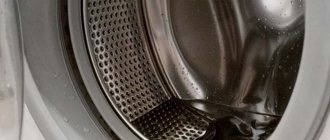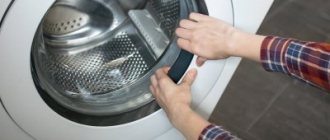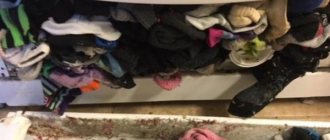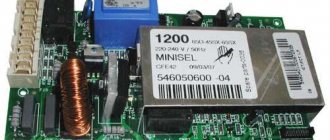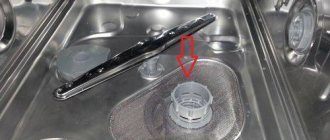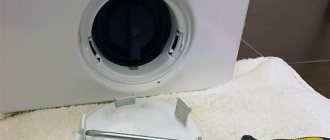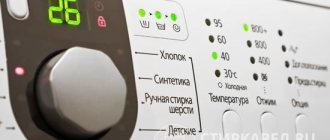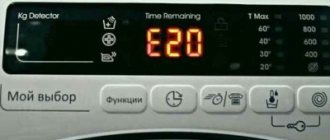Problems with such an important household appliance as a washing machine can turn into a real disaster for a person. But you shouldn’t immediately panic, sound the alarm and turn to expensive service services. A common situation: there is water left in the washing machine after washing. In most cases, the problem can be easily solved with your own hands, which takes a few minutes in total. What should you do if the washing machine stops draining water from the loading drum after washing?
If water remains in the detergent dispenser
A little water in the conditioner compartment after washing is normal, nothing needs to be done. It’s a completely different matter if the rinse aid compartment is full of water after washing or water remains in the powder compartment. Here you need to find out what the reason is and eliminate it, fortunately, in most cases this can be done on your own. Below is a list of reasons why water may remain in the detergent dispenser:
- Improper care of the detergent tray. Washing machine manufacturers recommend regularly washing the hopper to remove any residual detergent. If you forgot about this recommendation, the tray may have become clogged; it needs to be removed and thoroughly rinsed with water.
- The car is not level. If the washing machine is installed tilted forward, water may remain in the conditioner compartment. It is necessary to study the user manual and install the unit strictly at level.
- Poor quality detergents (powder, conditioner, etc.). Perhaps the reason is a low-quality washing powder or rinse aid, which has clogged the holes in the dispenser grid of the washing machine. Rinse the tray with running water, and next time try using a different brand of detergent.
- Too much washing powder. Perhaps you pour too much washing powder into the machine tray, it clogs the flush, hence the water in the powder compartment after washing. Try reducing the amount (check the machine manufacturer's recommendations for the amount of washing powder).
- Weak pressure in the water supply. As a result, the powder and/or conditioner are not completely flushed out of the compartment and clog the holes in the dispenser. In this case, water and detergent remain in the tray. Check whether the water supply valve to the washing machine is fully open. If so, then this is probably the reason for the low pressure.
How to prevent breakdowns
Turning to the statistics, you can see that breakdowns of the drain system occur already in the second or third year of intensive use of the washing machine. Most likely, this is due to the use of low-quality parts during assembly. In an attempt to save on production, companies purchase parts from cheap materials, which ultimately causes malfunctions.
Incorrect installation and connection to the sewer can also shorten the service life of a household appliance. Exceeding the standard length increases the load on the system several times, leading to its wear. To avoid such problems, experts recommend strictly following the requirements of the technical passport.
The occurrence of blockages can also be prevented by following fairly simple tips:
- Check the pockets of items before loading them into the drum; remember, it is unacceptable for debris and small objects to get into it.
- Periodically clean the drain filter to remove any remaining debris and sediment.
- Arrange sessions for complete cleaning of the automatic machine. Experts advise using citric acid or specialized detergents.
To summarize, we can say that liquid retained in the loading drum at the end of the washing algorithm is a clear signal of a problem. Do not delay in eliminating them: this can lead to serious accidents. Carry out independent diagnostics or call competent repair service specialists. Take care to promptly remove waste fluid from the tank to avoid the occurrence of unpleasant odors. There is no need to stop cleaning and checking system parts after a long period of perfect operation. The washing machine system needs regular maintenance, don't forget about it, and it will work like a clock.
If the washing machine does not finish washing and there is water left in the drum
First, check which wash program you have selected. Many washing machine models have a water-stop wash cycle (for delicates or woolen fabrics). Perhaps you have washed using such a program? Then just turn on the drain mode.
If the machine does not drain and there is still water in the tank, most likely the pump is faulty. You can learn more about other possible malfunctions and how to eliminate them from the article “Wet case: the washing machine does not drain water.”
Water removal and repair work
Before starting any preventive or repair procedures, it is necessary to disconnect the household appliance from the power supply and shut off the water supply. After this, be sure to check whether the hose running along the back panel of the washing machine is not bent. It should be in its normal position, without obstructing the flow of clean and waste water. Next, you can begin to remove the remaining liquid after work. Prepare a bucket, shallow container and dry rags in advance.
You can also drain the water accumulated in the drum through the drain system hose. Disconnect it from the siphon and simply lower it into the basin prepared in advance. This way you can make sure the hose is working and check whether it is clogged.
Water coming out without any difficulties serves as a signal that the hose is working, and after this procedure it can be returned to its place.
Hose clogged
If the problem is still a blockage, it must be eliminated. Disconnect the hose from the washing machine, then, using a special brush and cable, thoroughly clean its internal walls from accumulated deposits. After completing the procedure, rinse the hose with clean water and return it to its place.
Drain filter clogged
After draining the water through the hose, you can begin diagnosing the drain filter. As a rule, it is located in the lower compartment, directly behind the outer panel or special plate. When removing the filter, unscrew it counterclockwise and pull it towards you. If you find a blockage, remove it with a brush and running water. After thorough cleaning, reinstall the drain filter. There should be no debris or foreign bodies left on it.
Pump failure
If you do not find any faults in the filter, you will have to check the drain system pump. The pump of different models of washing machines is installed in different places. On devices such as Samsung and LG, I mount it closer to the bottom panel. In German analogues, you will have to tinker with disassembling the dashboard and dismantling the hatch. Read about where the pump is located here.
Pressostat failure
In addition to those described above, the cause of water retained in the drum may be incorrect operation of the pressure switch. In this case, you will have to diagnose it. A worn out water level sensor may not correctly alert the control processor. This may cause some liquid to remain in the drum. You can check that it is working properly as follows:
- remove the top panel of the washing machine;
- get to the pressure switch, as a rule, it is located in the upper compartment of the system;
- disconnect the wiring and hoses leading to the sensor;
- check the tubes for blockages, microcracks and kinks;
- check and clean the electrical contacts of the device;
- using a multimeter, examine the resistance of the pressure switch;
- If the slightest malfunction occurs, replace the sensor with a new one.
Replacing this part in a timely manner will help you prevent serious damage in the future.
Choosing cleaning products
If you notice that the rubber band in the washing machine has turned black, first find the source of the fungal infection. Check the cuff and if there is an infection there, proceed with cleaning using a pre-selected product.
Don't know how to remove mold from the rubber band of your washing machine? Most housewives use the following means:
If you are more concerned about the question of how to clean the cuff of a washing machine from scale, use proven products with positive reviews. These include:
- citric acid (regular, food grade);
- 9% vinegar;
- special anti-scale products.
Pollution prevention
Before using the washing machine, you must read the instructions. Each model, including Veko or Candy, has its own characteristics. It must be borne in mind that the more often the device is used, the faster the filters become clogged . In winter, you have to wash woolen items often; lint clogs the mesh, so the parts require cleaning. Experts advise buying rinses, conditioners and products from well-known manufacturers. If possible, you need to install an additional filter to purify the water. A good option is to purchase a unit with built-in enhanced recovery. Before throwing clothes into the wash, you need to carefully check your pockets to make sure there is no debris in them . You cannot leave things in the washing machine for a long time, otherwise fungal spores will begin to multiply, which will lead to clogging.
Before cleaning the filters, you need to find out what led to their contamination and decide on the type of product. In many ways, the service life of an automatic washing machine depends on proper care.
? Top 10 washing machine filter cleaners
Preventing malfunctions
If you want to avoid problems with blockages, then follow these recommendations:
- it is necessary to systematically process (clean) the drainage filter;
- Before throwing any item into the drum of the washing machine, be sure to check its pockets for debris;
- Clean your washing machine using, for example, citric acid (or another detergent of your choice).
Well, in any case, if there is water left in the drum, then your washing machine requires repair. This is your business, but we strongly recommend using the services of professionals and calling a specialist. As statistics show, in most cases, independent actions lead to the complete failure of the device.
How to clean correctly
But choosing the right tool is only half the battle. The main thing is to perform the procedure correctly so as to achieve the result and not damage the equipment.
Do the work according to this algorithm, then you will succeed.
Work order
- Using a rubber gloved hand, push back the cuff. Try to turn it inside out so that the inside is on the outside. From the folds between the elastic , remove debris, visible areas of mold and plaque.
- Apply a cleaning agent with disinfectant additives to the sponge. Wipe all elements of the cuff.
- Close the door and leave for several hours for the cleaning products to take effect.
- Set the washing machine to the longest wash cycle. This way, all elements are thoroughly washed from dirt and fungal colonies.
- Rinse all elements
with hot water . - Wipe the parts with a dry cloth.
- Leave the door open to allow the machine to dry completely.
Attention! Sometimes fungi form large colonies and corrode structural parts. In severe cases, the O-ring must be removed or replaced before cleaning.
The pump is broken
Nothing lasts forever - the pump may simply fail. It is located at the bottom of the case, but not all models have easy access to it. Before disassembling the machine, you should carefully read the instructions and find where exactly the part is located. The pump has an impeller that often gets clogged.
If after cleaning a miracle does not happen, it means the winding has burned out and the part needs to be replaced. Depending on the model, select a pump, disconnect the pipes from the broken one and connect to the new one.
Why does the seal require special attention?
All machine parts require periodic cleaning and maintenance. Sealing rubber is no exception. The fact is that high humidity due to direct contact with water. In addition, if you “open” this casing, you will definitely find debris there. Not the best place to store any contaminants, you know!
Important! Debris accumulated under the rubber band can lead to the formation of mold, rotting and the appearance of an unpleasant odor in the body of the machine.
In general, there is no choice: you must clean it! But this needs to be done correctly. Will learn!
Water appears in a non-working machine
When the liquid in the drum of the device arrives and the machine is in a non-working position, the aquastop system does not work, since the sensor is located in the pan near the floor. All the liquid pours out.
The device fills with liquid if:
- the supply or siphon valve is broken;
- there is no siphon valve at all;
- The drain system is clogged, and all the drainage ends up in the drum instead of the sewer.
To fix the breakdown, you need to turn off the tap through which water flows and disconnect the equipment from the electricity.
Read more ► The washing machine produces electric shock on the body and through the water: how to fix it, what not to do
If the drum still fills with liquid, you need to carefully check the connection of the unit. If the drain hose is not connected correctly, the tank of the machine will fill with sewage.
If everything is connected according to the instructions, the reason for the appearance of liquid may be the accumulation of a blockage inside the pipe. Sewage will begin to collect inside the machine.
And since they will have nowhere to go, everything will go down the drain. To fix this, you need to clear the clog.
Inlet valve fault
Malfunction of the inlet valve
Liquid penetration into the drum occurs through a cracked membrane, which is damaged during operation of the device. The membrane inlet channel does not close due to a contaminated area.
A clog creates a favorable environment for the development of microbes and unpleasant odors. To diagnose the problem, turn off the supply valve. If it stops flowing into the drum, then it is necessary to replace the valve with a new one.
For this:
- Close the valve and disconnect the cable.
- Before removing the valve, the hoses are disconnected from the nozzles.
- Instead of the old valve, a new one is inserted.
Premium service in our online store
Our branded online store sells original Miele household appliances in the Russian Federation. You can get acquainted with the range of VIP-class washing machines and order the model you like directly on this website through the online form or by calling the specified contact numbers.
All household appliances are covered by an extended warranty from the manufacturer - 24 months. A list of authorized Miele service centers located in all major cities of Russia can be opened by following the link from the “Warranty” page on our website. There you can leave a request for equipment maintenance or a request for spare parts and accessories for it. Delivery of goods throughout Moscow, St. Petersburg and regions of Russia is provided.
Breakdowns and ways to solve them
- If you detect water a few days after the “washing” procedures
So, first you need to turn off the tap that supplies water to the machine. If nothing has changed and the water continues to “visit” the drum, then the problem lies in the malfunction of the creamer. If you turn off the tap and after that the water stops bothering you, then you will have to disassemble the machine.
In this case, you need to check the drain filter. In all washing machines it is located at the bottom and is closed with a lid. If after opening you notice dirt there, then just clean it and everything will work. Otherwise, read the paragraph below.
This is the worst option. If the machine is trying to drain water and is buzzing, then the pump will need to be replaced or, at best, repaired. If the machine doesn’t even try to drain the water, then you need to call a technician, because you probably won’t be able to do it yourself.
- The water drains, but not completely
In this case, the culprit is the sensor that is responsible for the water level in the machine. Maybe the problem lies with the pump, but it's unlikely. To find out which of these two options has disturbed your car, position the drain hose a little lower. If the problem lies in the pump, then the water will drain.
How to remove the drain filter: step-by-step instructions
Proceed as follows:
- Turn off the power to household appliances - this is a mandatory step for any repair or maintenance.
- Shut off the fluid supply fittings.
- Open the decorative panel or hatch door. Behind it is a part that is held on hinges.
- Disconnect the pipe, do not forget that liquid will flow out of it.
- Place a container under the hatch, tilt the equipment itself slightly for easier draining.
- Next, you need to remove the screws with a screwdriver and unscrew the snail.
- After cleaning, reassemble in reverse order.
Can't unscrew
Sometimes it is not possible to unscrew and remove the filter due to various objects stuck in it. Hair, socks and handkerchiefs, coins, beads and other small items during washing can end up in the catcher in front of the pump and plug it. Limescale deposits on the threads, which occur if the filter has not been removed for a long time, can also become an obstacle.
In this case, there are three ways to open the garbage filter. Apply them in turn, proceeding to the next method only if you tried the previous one and it did not help. Before you begin, be sure to unplug the machine and close the valve to prevent water from flowing.
- 1 way . Use pliers or pliers to unscrew the filter cap. There is a handle on it that you need to try to turn using a tool. Manipulations should be carried out very carefully so as not to break the filter part.
- Method 2 . Lightly tap the drain pump filter cover several times while tilting the washing machine.
This method is suitable when:
- The garbage filter cover does not rotate at all;
- partially rotates;
- It can be unscrewed, but it cannot be removed.
Tilt the machine back and lean it against the wall. Tap the dust filter cover and the housing next to it. If the snag is in small objects that have stopped the desired part, then the knock will cause them to move, and you can unscrew and pull out the filter.
3 way . If the previous two methods were unsuccessful, then you need to completely remove the drain pump. The task is to clean the snail and remove the filter. This method is quite complicated - you need to get to the pump, unhook the pump from the volute and through the resulting hole get to the filter.
The design features of certain models of Kandy washing machines allow the drainage pump to be dismantled through the bottom. If it is easily removed or is absent altogether, then it is easier and more convenient to get the snail with the pump in this way. Putting the machine on its side or simply tilting it in the desired direction and resting it on the wall, remove the bottom and find the pump. It is located behind the filter, that is, in the lower part of the housing.
The listed methods should only be used if you are confident in your abilities and have certain skills in repairing various devices. If the filter does not unscrew and you are not very well versed in technology, it is better to call a specialist. It must be remembered that through ignorance you can not only waste time, but also worsen the situation.
